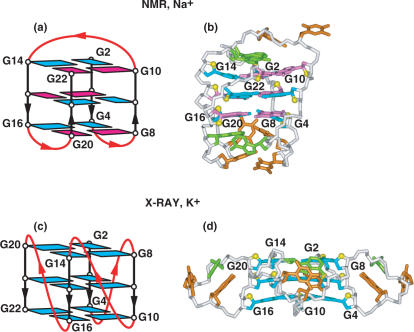Figure 5.
NMR-based (a) folding topology and (b) solution structure of the four-repeat human telomere unimolecular G-quadruplex formed by the d[AG3(T2AG3)3] sequence in Na+ solution (coordinates deposition: 143D) (9). The loop types starting from the 5′-end are edge-wise, diagonal and edge-wise. Individual strands have both a parallel and anti-parallel neighbor, with the G-tetrads adopting syn–syn–anti–anti alignments. X-ray-based (c) folding topology and (d) crystal structure of the four-repeat human telomere unimolecular G-quadruplex formed by the d[AG3(T2AG3)3] sequence for crystals grown from K+ solution (coordinates deposition: 1KF1) (17). All three loops are of the double-chain-reversal or propeller type, all strands are parallel and all guanines adopt anti alignments.

